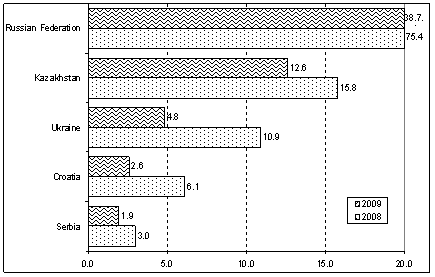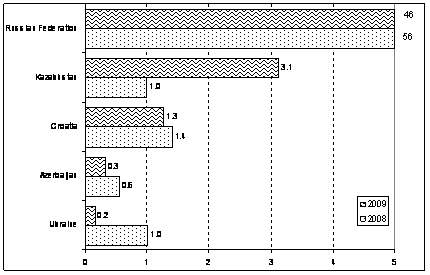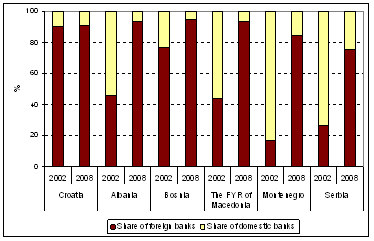| EMBARGO The contents of this press release and the related Report must not be quoted or summarized in the print, broadcast or electronic media before 22 July 2010,17:00 [GMT] (13:00 New York; 19:00 Geneva, 22:30 New Delhi, 02:00 - 23 July 2010 Tokyo) |
Geneva, 22 July 2010 - Foreign direct investment (FDI) flows to the transition economies of South-East Europe and the Commonwealth of Independent States (CIS) are expected to increase moderately in 2010 on the back of higher commodity prices and faster economic recovery in large commodity-exporting countries (Kazakhstan, the Russian Federation and Ukraine) (table 1).
The World Investment Report 2010: Investing in a Low-Carbon Economy (1) has been released today by the United Nations Conference on Trade and Development (UNCTAD). The Report reveals that FDI inflows to the region declined by 43%, to $70 billion in 2009 as the economic and financial crisis reduced foreign investors´ confidence in the strength of the region´s economies, and investment plans were scaled down or postponed.
In the CIS, all resource-based economies suffered from major drops in their FDI inflows in 2009. A fall in the demand for, and the price of, the main export commodities of the CIS led to that sharp decline in FDI flows to the subregion. FDI to the region´s largest economy, the Russian Federation, almost halved, mainly due to sluggish growth of the economy and local demand, diminishing returns of natural-resource-related projects in the country and the drying-up of round-tripping FDI. The region´s second largest economy, Ukraine, saw its FDI inflows shrink by more than half in 2009 as it was hit strongly by the global financial crisis. In turn, the decline in Kazakhstan was modest, as the country continued to be attractive for hydrocarbon projects. These three countries continued to occupy the three top positions as recipients in 2009 (figure 1).
In South-East Europe, the winding-up of privatization-linked projects has made FDI inflows sensitive to downturns in the world economy. However, FDI flows to the subregion were less affected than to the CIS, as foreign investors still found attractive projects in domestic market- oriented services. Finance was by far the largest recipient of inward FDI stock.
FDI in South-East Europe´s banking has been on the rise since the early 2000s, fuelled by restructuring and privatization. As a result, in 2008, 90% of banking assets were owned by foreign banks (figure 2). The latter have played a generally positive role during the global financial crisis. The recent Greek debt crisis, however, is reviving concerns that the large presence of foreign banks could channel systemic risks to the subregion.
The 16% contraction of outward FDI from the region, to $51 billion, was not as severe as the decline in inflows. Transnational corporations from the Russian Federation ? by far the largest investor from the region (figure 1) ? continued to acquire strategic assets, mainly in petrochemicals, in developed countries.
Most of the recent policy measures in the region concerned investment promotion, including by simplifying business registration (e.g. Tajikistan and Turkmenistan), reducing restrictions for foreign currency transactions (e.g. Kazakhstan) or improving conditions in special economic zones (e.g. Russian Federation). In one case, however, local content requirements in the subsoil sector were reinforced (Kazakhstan).
The World Investment Report and its database are available online at http://www.unctad.org/wir and http://www.unctad.org/fdistatistics and http://www.unctad.org/diae |
ANNEX
Tables and figures
Table 1. South-East Europe and CIS: FDI flows in selected countries, 2009-2010, by quarter (Millions of dollars) 
Source: UNCTAD, World Investment Report 2010.
Figure 1. Transition economies: top 5 recipients and sources of FDI flows, 2008, 2009a (Billions of dollars)
a) Inflows

b)outflows

Source: UNCTAD, World Investment Report 2010.
Note: a Ranked on the basis of the magnitude of 2009 FDI flows.
Figure 2. Share of foreign banks in total bank assets in South-East Europe, 2002 and 2008 (Per cent) 
Source: UNCTAD, World Investment Report 2010.


